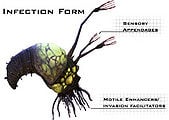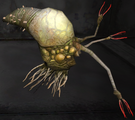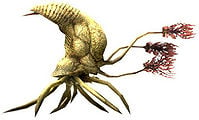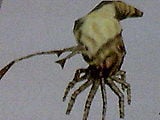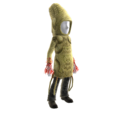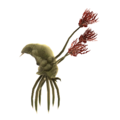Pod infector
From Halopedia, the Halo wiki
| This article does not meet the wiki's general standards and/or standards on layouts. You can help by cleaning this article. |
| This article does not have enough inline citations and/or does not adhere to the proper citation format. You can help Halopedia by adding citations. |
Template:Flood Species Infobox
The Flood infection form is a stage of the virulent Flood xenoform. It is the most commonly seen stage of the Flood, and is the primary form responsible for spreading the Flood infection due to its effectiveness compared to mere Flood spores when deployed in large numbers.
Overview
Infection forms are the primary vector for the Flood infection. While small (roughly the size of a human torso) and weak, they travel in huge swarms and overwhelm foes using sheer numbers. Once within range of a potential host, they leap for the victim's chest area, rasping away at armor, clothing and flesh with their numerous tentacle-like limbs. These appendages penetrate deep into the body, tap into the victim's spinal cord, and unleash an attack on the host's nervous system via direct contact with the spine, killing the host almost instantly. Once this is accomplished, the form rewrites the neural pathways of the victim's brain with its tendrils, forcing a resonant frequency match between its neural signals and the host's. At this point, the infection form has complete control over the body's motor functions.
As the infection form hacks into the host's nervous system, it releases encapsulated Flood Super Cells into the body. These cells interface with the host's cells, "digest" them and convert their components into new Flood cells. At this point, the infection form burrows into the host body, moving aside the internal organs and taking up residence within the chest cavity (or any approximate equivalent). Having achieved total control over the host, the infection form reshapes the body into a form more suitable for attacking enemies - a combat form.
The speed and intensity of this process occurs at the same rate as an energetic chemical reaction, often taking mere seconds to accomplish. The consequences for the host organism are extreme, as their brains are purged of all traces of their original personality and their bodies are reconstituted into Flood biomatter. The organism effectively becomes a pawn of the Flood's collective intelligence, to be used in any way it deems necessary.
In exceedingly rare cases, such as if the infection form has been damaged or is incredibly old, it will go through this process without killing the host, leaving them at least partially aware of what is going on, but unable to move or act. This was the fate of UNSC Private Wallace A. Jenkins during the raid on the "Covenant weapons cache" on Installation 04.[1] This aged version of the infection form must have been kept in captivity for far too long, thereby reducing its potential of complete transformation of its host into a Flood combat form. Jenkins survived infection, and even remained conscious, with short periods of time where he could exert control over his mutated body.
An infection form may abandon its host if the corpse has been heavily damaged, and look for a new one. If the infection form inside a combat form has been destroyed, but the combat form itself is intact enough to continue serving its purpose, loose infection forms may burrow inside the body and take the place of the one that mutated it, effectively "re-animating" the combat form.
Infection forms develop from a form vaguely resembling a larva or tadpole but bearing the basic superficial characteristics of an infection form. A number of Flood forms in this stage of their life cycle were kept in stasis by the Forerunners in Flood research facilities, such as the one in the Threshold gas mine.[2]
While an effective vector of infection against armored and shielded organisms as well as those equipped with atmospheric filters, an infection form is not necessary for the Flood to infect a host; merely ingesting Flood spores or inserting them via a wound is sufficient to initiate Flood conversion. Such infection may occur several seconds or perhaps minutes later, yet the transformation will occur almost instantaneously once it has begun.[3][4]
Weaker host forms
While any large life form with some level of awareness and/or sentience can be infected by an Infection Form, not all of them are suitable to serve the function of Combat Forms, the Flood's signature and preferred mobile form utilized during the Feral Stage. While these hosts are transformed in a similar fashion to the traditional Combat Forms, these forms are not often employed in front line combat for several reasons.
The first of these would be the fact that such life forms, despite their sophisticated nervous systems and adequate levels of sentience, simply lack the necessary biomass, calcium reserves, and physical strength to make first-choice combat units. More specifically, when a host life form is transformed, the activities of the Infection Form require not only the aforementioned levels of biomass, calcium content, and physical strength, but that the host has the physical endurance and stamina to withstand the process. Species such as humans, Forerunners, Sangheili, and the Jiralhanae are almost always turned into combat forms because their biology and physical properties enable them to withstand the infection forms' abilities, which are violent and resource-intensive.
In contrast, weaker life forms, such as the Kig-Yar, Unggoy, and perhaps the Yanme'e, lack these important qualities despite their perfectly adequate levels of sentience and neural complexity. Because of these factors, these lesser hosts are primarily used for other but equally important purposes. These involve multiple mission profiles that are essential to the development of Flood outgrowth: establishment of mobile incubators, biomass and calcium reserves, hive structures, and the components of a coordinating and controlling intelligence.
When utilized for the creation of the hive and the central intelligence, the weaker hosts gather together and merge into single mass or a collection of masses spread around whatever environment the Flood have established themselves in. In this way, the weaker host forms serve as 'building blocks' for the creation of a Flood Hive, which if all goes according to its logical conclusion, will spawn a fully-developed collective and the next stage of the Flood's development: the Coordinated Stage and its crowning achievement, a Gravemind. Surrounding life forms such as significantly smaller animals as well as the full range of plants, microbes, lichens, and fungi, are seized by the growing Flood collective and digested as raw material to create more generic Flood biomass.
The next vital use for lesser hosts is to serve as the second signature form of the Feral Stage, the mobile Infection Form incubator known as a Carrier Form. While these are usually formed from weakened, damaged, and/or aged Combat Forms, weaker host forms are just as frequently employed for this purpose. The first step in the creation of a Carrier Form by this method involves a single appropriate host to function as a nucleus, which is then followed by one or more other weaker forms attaching themselves to the leading unit. The congregated hosts then fuse, with the external host forms being rapidly digested by the central form, with the result being that the other hosts have been reduced to extra, generic biomass, contributing to the structure of the now significantly distorted, bloated incubator.[5]
While this complex methodology is largely standard procedure for the Flood, there are occasionally exceptions to these rules due to the Flood's adaptive nature. In at least one notable campaign[6] early in the Human-Covenant War, this mode of operation was contradicted by the Flood. The outbreak present on this installation employed Kig-Yar and Unggoy quite frequently as front line combat units despite their inadequate status, and was also distinct from other outbreaks with the fact that it was predominantly formed out of life forms lacking sentience such as plants, fungi, etc., or those possessing lower levels of sentience, such as the wide range of animals living there.
Immunities and defenses
Energy shielding destroys infection forms on contact, causing them to explode in a small burst of gas and flesh. Conventional body armor is generally ineffective against infection forms; they can easily squeeze through gaps in armor plating, and their rasping tentacles can burrow through rubber, fabric or polymer in order to reach the flesh underneath.
At this time, the only known human to be incompatible with Flood infection forms is Staff Sergeant Avery Johnson due to his supposed contracting of Boren's Syndrome from the residual radiation of a crate full of plasma grenades on Paris IV. In reality, his resistance to Flood infection was due to the augmentations he received as part of the ORION Project.[7]
The Mgalekgolo's lack of a central nervous system and nature as an invertebrate colony consisting of multiple worms likely make them immune to Flood infection.[8] The invertebrate nature of the Yanme'e, along with their hard, chitinous exoskeleton, would seem to make them immune as well. However, while their unique physiologies make standard infection difficult, it is likely that the Flood are still capable of consuming and converting Lekgolo and Yanme'e into Flood biomass.
Combat
In order to overwhelm hosts, infection forms attack in large swarms, leaping at any nearby targets and attacking with their claws and tentacles. If the victim's shields are active, as explained earlier, the infection form will burst. However, the sheer force of numbers can sometimes deplete a victim's shields, allowing these Flood forms to take control of the host's body.
While individual infection forms are weak, in large numbers they can exert a surprisingly powerful force, being able to shatter doors made of Forerunner alloys.
A single round from any weapon will burst an infection form. For this reason, automatic weapons are recommended. Dual-wielding Plasma Rifles, Brute Plasma Rifles, Spikers or using a UNSC ballistic weapon all work well. The Battle Rifle with its bursts fire can be quite effective and the Shotgun can work well too when shooting at large groups closing in. Try to avoid using weapons such as M6 Handguns, as their rate of fire is very low. Also, try to use Grenades, but be careful as sometimes Infection Forms can be stuck with Plasma Grenades and may harm you when it gets close. In Halo: Combat Evolved, automatic weapons like the Assault Rifle and Plasma Rifle are good on them as well as the Plasma Pistol, and the the Needler can turn out to be a very good alternative as the needles have homing ability. Be careful though, do not stick too many Needles on one at a time while they are close as if you do it will explode and effect you most likely depleting your shields. The best way of using it is to fire a single shot at each Infection Form, which is enough to kill them. SMGs are incredibly effective for taking on swarms of infection forms with its large magazine size and impressive rate of fire. The Sentinel Beam is also extremely effective and can swiftly obliterate entire swarms of infection forms at long ranged distances.
Infection forms are spawned from bulging, sac-like pods in Flood hives, called Flood growth pods. It may be tempting to destroy these sacs, but it is actually more advisable not to, since destroying them will not kill the infection forms inside.
Trivia
- In Halo: Combat Evolved, if an infection form latches itself onto a Marine or one of the Covenant, instead of mutating the host, it will become irrevocably attached until the host is dead. If at least one infection form manages to leap onto an unshielded player in this game, it will deal a noticeable amount of damage (this will increase depending on difficulty and number of infection forms attached), fall off, and attempt to strike the player again. This effect on the player also appears in Halo 3.
- An Energy Sword will not lose energy by killing infection forms in Halo 2 and Halo 3, but this method is highly ineffective as infection forms are extremely hard to hit with an Energy Sword.
- Infection forms do not add points to the player's meta-score when the Campaign Scoring is activated in Halo 3. This is most likely because infection forms come in swarms, and could be used to rack up points with almost no effort.
- Infection forms operate in a similar fashion to the chestbuster Xenomorph (being inside a host's chest) and the facehugger Xenomorph of the Alien franchise, the Borg Nanoprobes of the Star Trek franchise, the Headcrabs from the Half-Life series, and the Thing from the John Carpenter film of the same name.
- The infection forms in Halo 3 float in water. Thus, they cannot infect corpses that are in water ponds because of this animation. (E.g. on the level Halo it will appear different close up then it will farther away.) However, in Halo: Combat Evolved, they sink.
- In Halo Wars, when Sergeant Forge shoots the Flood infection forms that are attacking Professor Anders, they do not pop like all other infection forms. Instead, they simply fall lifelessly to the ground.
- In Halo PC, if the player uses cheat_bump_possession to take over a Marine or a Grunt, they will have no control over their body if an infection form latches onto them.
- In Halo 3, code exists for a deleted "banger" variant of infection form, which would explode like a plasma grenade when destroyed.[9]
Gallery
An infection form in the Threshold gas mine.
- BabyFloodCloseup.jpg
An infection form in Halo 2.
Infection forms assaulting Professor Anders.
An Xbox 360 Avatar customized with a Flood Infection Form suit.
The Librarian investigating a Flood infection form.
A Flood infection form inside the UNSC Spirit of Fire's cryo-room.
- Infectionforms Halo1.jpg
The Master Chief watches as infection forms prepare to consume a dead Elite and a dead Grunt.
List of appearances
- Halo: Combat Evolved
- Halo: The Flood
- Halo: First Strike (Mentioned only)
- Halo 2
- Conversations from the Universe (Mentioned only)
- Halo: Graphic Novel
- Halo 3
- Halo Wars
- Halo Legends
- Halo: Evolutions - Essential Tales of the Halo Universe
- Halo: Combat Evolved Anniversary
- Halo 4
- Halo: Spartan Assault (Simulation-only)
- Halo: Escalation
Sources
- ^ Halo: The Flood, page 176
- ^ Bungie.net: One Final Effort (4/16/2010)
- ^ Halo Wars, campaign level Anders' Signal
- ^ Halo: Evolutions — "The Mona Lisa"
- ^ 'Halo: The Flood', page 291
- ^ Halo Wars
- ^ Halo Graphic Novel, page 122
- ^ Halo: First Strike
- ^ YouTube: Halo 3 - Cut Enemy: Flood Infection "Banger"
| |||||||||||||||||||||||||||||||||
